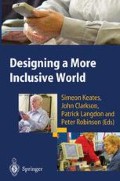Abstract
This work is part of the Aurora project which investigates the possible use of robots in therapy and education of children with autism (Aurora, 2003), based on findings that people with autism enjoy interacting with computers, e.g. (Powell, 1996). In most of our trials we have been using mobile robots, e.g. (Dautenhahn and Werry, 2002). More recently we tested the use of a humanoid robotic doll. In (Dautenhahn and Billard, 2002) we reported on a first set of trials with 14 autistic subjects interacting with this doll. In this chapter we discuss lessons learnt from our previous study, and introduce a new approach, heavily inspired by therapeutic issues. A longitudinal study with four children with autism is presented. The children were repeatedly exposed to the humanoid robot over a period of several months. Our aim was to encourage imitation and social interaction skills. Different behavioural criteria (including Eye Gaze, Touch, and Imitation) were evaluated based on the video data of the interactions. The chapter exemplifies the results that clearly demonstrate the crucial need for long-term studies in order to reveal the full potential of robots in therapy and education of children with autism.
Access this chapter
Tax calculation will be finalised at checkout
Purchases are for personal use only
Preview
Unable to display preview. Download preview PDF.
References
Adler, J. (1968) The study of an autistic child. In: Proceeding of the 3rd annual conference of the American Dance Therapy Association 1968, Madison, Wisconsin, USA
Aurora (2003) The aurora project. Available at: http://www.aurora-project.com
Billard A (2003) Robota: Clever toy and educational tool. Robotics & Autonomous Systems 42: 259–269
Costonis M (ed.) (1978) Therapy in motion. University of Illinois Press, Urbana
Dawson G, Adams A (1984) Imitation and social responsiveness in autistic children. Journal of Abnormal Child Psychology 12: 209–26
Dautenhahn K, Billard A (2002) Games children with autism can play with robota, a humanoid robotic doll. In: CUWAAT’02, Springer-Verlag London, UK
Dautenhahn K, Werry I, Rae J, Dickerson P, Stribling P, Ogden B (2002) Robotic playmates: analysing interactive competencies of children with autism playing with a mobile robot. In: Socially Intelligent Agents. Kluwer Academic Publishers
Evans K, Dubowski J (2001) Art therapy with children on the autistic spectrum: Beyond words. Jessica Kingsley Publishers, Philadelphia, PA
Ferrara C, Hill S D (1980) The responsiveness of autistic children to the predictability of social and non-social toys. Journal of Autism and Developmental Disorders 10(1): 51–57
Hames J G, Langdell T (1981) Precursors of symbol formation in childhood autism. Journal of Autism and Developmental Disorders 11: 331–44
Jordan R (1999) Autistic spectrum disorders - An introductory handbook for practitioners. David Fulton Publishers, London, UK
Kalish B (1968) Body movement therapy for autistic children. In: Proceeding of the 3rd Annual Conference of the American Dance Therapy Association 1968, Madison, Wisconsin, USA
Levy F (1988) Dance movement therapy - A healing art. The American Alliance for Health, Physical Education, Recreation and Dance, Reston, VI
Meltzoff A, Gopnik A (1993) The role of imitation in understanding persons and developing a theory of mind. In: Perspectives from autism. Oxford University Press, UK
NAS (2003) National Autistic Society UK. Available at: http://www.nas.org.uk
Nadel J, Guerini C, Peze A, Rivet C (1999) The evolving nature of imitation as a format of communication. In: Imitation in Infancy, Cambridge University Press, UK
Payne H (1990) Creative movement and dance. Winslow Press, Oxfordshire, UK
Powell S (1996) The use of computers in teaching people with autism. In: Autism on the agenda: papers from a National Autistic Society Conference. London, UK
QCA (2003) The Qualifications and Curriculum Authority. Available at: http://www.qca.org.uk/ca/foundation/profiles.asp23p_scales
Rogers S J, Pennington BF(1991)A theoretical approach to the deficits in infantile autism. Development and Psychopathology 3: 137–162
Siegel E V (1984) Dance-movement therapy: mirror of our selves - the psychoanalytic approach. Human Sciences
Tardiff C, Plumet M-H, Beaudichon J, Waller D, Bouvard M, Leboyer M (1995) Microanalysis of social interactions between autistic children and normal adults in semi-structured play situations. International Journal of Behavioural Development 18(4): 727–747
Tiegerman E, Primavera L (1981) Object manipulation: An interactional strategy with autistic children. Journal of Autism and Developmental Disorders 11: 427–38
Werry I, Dautenhahn K, Ogden B, Harwin W (2001) Can social interaction skills be taught by a social agent? The role of a robotic mediator in autism therapy. In: CT2001, Springer Verlag, London, UK
Editor information
Editors and Affiliations
Rights and permissions
Copyright information
© 2004 Springer-Verlag London
About this paper
Cite this paper
Robins, B., Dautenhahn, K., te Boekhorst, R., Billard, A. (2004). Effects of Repeated Exposure to a Humanoid Robot on Children with Autism. In: Keates, S., Clarkson, J., Langdon, P., Robinson, P. (eds) Designing a More Inclusive World. Springer, London. https://doi.org/10.1007/978-0-85729-372-5_23
Download citation
DOI: https://doi.org/10.1007/978-0-85729-372-5_23
Publisher Name: Springer, London
Print ISBN: 978-1-4471-1046-0
Online ISBN: 978-0-85729-372-5
eBook Packages: Springer Book Archive

